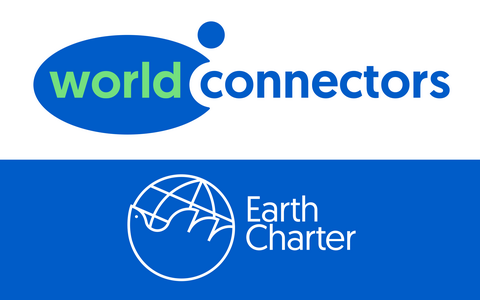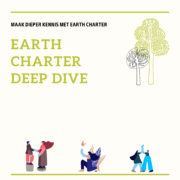Earth Charter Deep Dive 31 januari
Tuesday 31 January 2023 was another Earth Charter deep dive, which is the second one of a three–part series meant to introduce Worldconnectors to the Earth Charter (EC) document. The first session discussed the political context of the creation of the document as well as the value created by the EC. We talked about the ability the EC holds to inspire people to action and the power of the organisation behind the document that sustains the EC movement. This session focussed on how members and supporters of EC can incorporate the values of the document into their everyday lives and professional projects. This is also relevant for Worlconnectors as an affiliate organisation of EC.
Couldn’t be there the 31st? See the recording of the session below, or read on for the report.
Introduction and welcome
Around 18:30, when most participants have logged into the Zoom call, Veronique Swinkels and Alide Roerink open the session by welcoming everyone and introducing the speakers for the evening: Alicia Jiménez, who works at the Earth Charter International (ECI) secretariat as director of programmes and Tonia Moya who is the executive director of Green Cross Sweden and a board member of Green Cross International. Mirian Vilela, executive director of ECI, will also be joining the session later to talk a bit about her work.
After introductions are made, Veronique asks Alicia to share a paragraph of the EC that motivates and inspires her. Alicia takes the floor and explains that principle two, “Care for the community of life with understanding, compassion, and love”, is a sentence that moved her. The centrality of love especially, has stayed with her ever since the first time she read it and it made her see environmental protection in a completely different light, namely that you can also love that which you are trying to protect, and you do not have to only approach it from a logical, scientific angle.
What ECI offers
Following this, Alicia is asked to kick off the presentation and talk about the work she does for ECI and how that overlaps with the work of affiliates. She starts by explaining that ECI is an organisation that is a small core of the bigger Earth Charter movement. It is a coordinating body that operates highly decentralised and does not give anyone guidelines or instructions, but instead provides motivation and tools that can connect people. The ECI itself exists out of two sub–organisations. The first one is the secretariat, which works like an NGO and works on communication and information provision between all the different actors and partners working with the EC. They gather stories of people and projects all over the world and provide a central information hub where these stories are gathered. In that way, they hope to inspire new action and keep the EC values alive.
The second part of ECI is the Earth Charter Centre for Education and Development. To illustrate what this Centre does, Alicia starts sharing her screen with the participants to show the website of ECI. As she opens the website, we see a slogan popping up: “Turning conscience into action”. Alicia points out that this is ECI’s slogan since 2020 and that it embodies what ECI wants: not just to inspire, but to also undertake action.
She then clicks through the website until a world map appears on the screen. On this page, you can find an overview of projects and organisations that are doing work related to the EC. It also includes some stories and events, as well as partner organisations, affiliates and educators. Having a central hub of information helps maintain and sustain the movement, as it is good to see that people are actively engaging with EC. However, Alicia goes on to explain that it is a lot of work to compile a map like this. So if anyone has any stories, about an organisation or person that is doing good work, that you want to share, then please reach out to us so we can put them on the website. That would be one way in which you personally can support ECI.
Then, the Education Centre. The activities organised there are slightly different, but they still promote the vision of EC. The campus is located on the UN Mandated University for Peace in San José, Costa Rica and you are always welcome to join the (online) masterclasses. For example, there is one course for young people called Leadership, Sustainability & Ethics (LSE) Online Course, which is a 10–week course that brings people together from all over the world (right now over 500 people are enrolled). Another resource that is available via the website is a podcast series, that you can listen to for free and can be very inspirational. Further, you can check out the resource materials that are all free to access, for example, print versions of the EC document or presentations that can be downloaded, to name two examples.
A different interesting resource is the app Mapting, which works a little like Instagram. Here people can share pictures and videos with a focus on actions that implement SDGs and connect to EC. It is a great app to use, for example, within schools that are raising awareness about sustainability. While Alicia is explaining this, a question pops up in the chat: Regarding ECI’s target audiences (the people, governments at all levels, corporations, SMEs), how is the focus divided across those? For example the Mapting app. Who is it for?
Alicia answers that this is mostly for young people (18+) and that Mapting connects well with something like the Young Leaders programme. The other focus of ECI is on educators on all levels, elementary, high school and university. Mapting also works for them, as it is a great way to engage students. In regards to business, there are courses that target them (e.g. Business and Development courses), but the strongest focus is on educators and young people, although ideally this would be expanded. Another area of emphasis is the dialogue with UN processes, it is something ECI always tries to do and we have always had good connections with UN agencies. For example, something we would like is to be endorsed by the UN General Assembly, despite not being successful yet. But, we have been accredited now, which means EC gets to be more involved with UN processes. This is also something where ECI could use support from affiliates.
Here, Veronique takes over and asks Tonia, as an affiliate of ECI, to explain how her work connects to ECI and what her involvement is. Tonia answers by repeating her position, that she is the executive director of Green Cross Sweden and on the board of Green Cross International. And that, when she came into contact with the EC document, she immediately loved the emphasis on and inclusion of indigenous peoples. Furthermore, through her work at Green Cross, she has utilised EC in almost every event and forum she can think of, and it should be part of many more. For example, EC values should be part of national security programmes. It is such an inspiring document, attached to a worldwide movement and it is so interesting to hear which new initiatives Worldconnectors can bring to that network.
Meanwhile, Mirian entered the Zoom call and is welcomed by Veronique. However, before Mirian takes over, Alicia has one more point to add. She wants to highlight the existence of the EC Social Network, where people involved with EC can sign up and create a profile. It functions like Facebook, a social network thus, but it is internal to the EC network and not open to public access. It is a great tool to reach out to other people that are working with EC.
Mirian follows this up by stating that the key challenge of ECI is communication. It is figuring out how we communicate what people all over the world are doing. We do have the policy that at least on our website we communicate what people are doing with EC. It does not matter if it is an organisation or an individual, as long as they are doing something with EC we want to communicate that on our website. That is also what the EC Social is for. It is a way for people to communicate. And a space for someone to say, for example, that they wrote something about EC and can share it there.
Coming back to the challenge of communication, one function of the secretariat is to help take inventory and categorise what is happening, and put all this information together. And, yet, people still do not have all the information, but we try to communicate via social media, through news flashes and a Google group. It is important to try to communicate from all ends of the network. In this regard, EC Social is just an extra effort to connect people working with EC with each other.
While Mirian is explaining this, the link to register for EC Social is shared in the chat. Alide remarks that this is a very interesting site, she herself is already on it, and that it is a great tool to use when looking for people that are working in the same fields of interests and/or localities as you are.
Breakout rooms
Veronique takes over and suggests the participants go into breakout rooms for 10 minutes to discuss what they can do in their own sphere of influence to promote EC. When everyone has come back to the main session, Veronique asks if anyone would like to share what they discussed. The overall feeling is that everyone feels very connected to the EC document and implicitly feels there is a lot of overlap between the work they do and the EC. However, it is difficult to put into words how this connection can be made explicit. One participant does mention that in a project she works on, EC is utilised as a good basis for creating a common understanding. People can come from two very different backgrounds, and both find EC very valuable for their own reasons. Having this in common, they can then work together and find common ground. Alide also points out that we can incorporate EC in all Worldconnectors projects, we could help each other in figuring out how.
Closing words
Alide then moves on to closing words and says that one thought that entered her mind is that there are so many projects where EC is an inspiration and that it is really hard to know all that is happening. From that understanding, it is no surprise ECI’s secretariat is struggling to gather all information. However, it is also encouraging to see that the document is still relevant so many years later and that there are so many ways in which people work with EC.
As for these Earth Charter deep dives, the last one is on 14 February, also from 18:30 until 20:00, and will have more or less the same structure: first the sharing of information (to hopefully inspire) followed by space for interaction through breakout rooms. Next time, we will have guest speakers as well: Michel Scholte of True Price and Impact Institute, Monique van Dam representing One World Citizens and Wim Oolbekkink, who will share how EC came alive in Doorn at Landgoed Zonheuvel.
To close the session, Veronique emphasises that if you are not yet registered for the next deep dive, please feel free to do so via this link. She also thanks everyone, both participants and speakers, for coming tonight, and hopefully we will see each other on 14 February.



